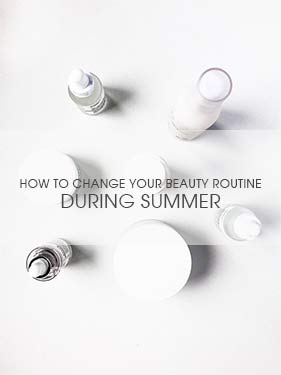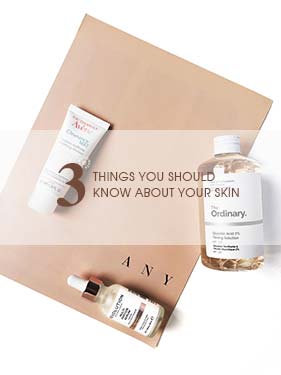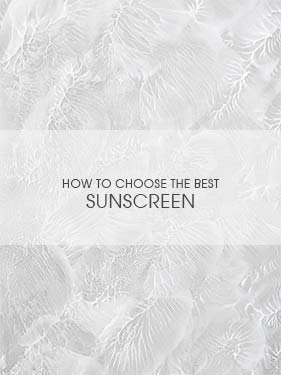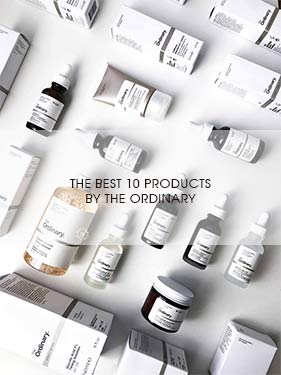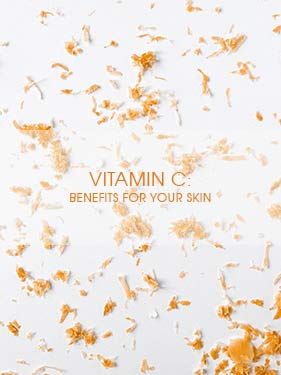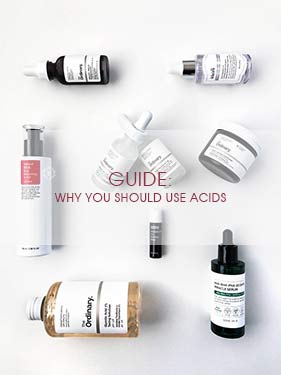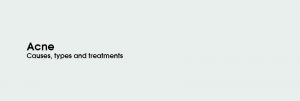Acne is one of the most common skin concerns. Minimizing those zits, pimples and comedones is often a difficult task that requires the supervision of a dermatologist. However, you can improve that acne with the right beauty routine and using adequate skincare actives. Do you know how can skincare help with your acne? Read on!
Seeing that my article on skin spots, their types and the best ways to treat them was very successful, I want to tell you about a topic that worries many: acne. If you suffer (or have suffered) and want to learn more about it, what types exist and the best ways to treat it, keep reading!
Specifically, the topics that you will find in this article are the following:
1. WHAT IS ACNE?
Acne (acne vulgaris) is a very common skin problem. It affects approximately 60% of young people between 15 and 24 years old and also appears frequently during adulthood, especially in women.
But what is exactly acne? It is a chronic inflammatory disease that normally arises as a consequence of various factors, among others:
- Excessive sebum production.
- Greater presence in the skin microbiota of Cutibacterium acnes (previously known as Propionibacterium acnes, a type of bacteria associated with acne and normally present on our skin even if we do not suffer from this condition, although it is more virulent in those who do.)
- Excessive proliferation of keratinocytes (the most common cells in the epidermis).
- Immune system disorders.
Besides this, other factors that can influence the appearance of acne have been observed, such as family history, stress, carrying out an unsuitable skincare routine (due to the use of irritating products and that weaken the skin barrier), or diet (despite the widespread belief that there is a relationship between acne and the consumption of dairy or chocolate, there is still not enough evidence to support it, although a balanced diet is always essential to maintain our health).
Now that you have an overview of the possible factors that lead to the appearance of acne, I think it is important to clearly describe the most common signs and symptoms. Although more research is still needed to clearly determine the order in which all the events leading to acne occur, it can be summarized in a simple way. Acne appears as a consequence of an obstruction of the hair follicles (where the hair is born) by an excess of keratin (that excessive proliferation of keratinocytes that I mentioned before), which leads to colonization by Cutibacterium acnes and inflammation. This obstruction results in the appearance of open (black dots) or closed (white dots) comedones and inflammatory lesions: pustules or cysts (nodules). Those comedones can lead to inflammation or not, depending on each case.
Frequently, despite having effective treatments to resolve it, acne leads to other skin problems, such as the appearance of spots (usually in the form of post-inflammatory hyperpigmentation) or scars.
In addition to visible skin changes, acne also has a significant psychological impact (greater than that caused by other chronic diseases) in both teens and adults, affecting the image we have of ourselves, leading to appearance of dissatisfaction and lowering our self-esteem. In fact, a relationship between acne, depression and anxiety has been observed, and the popularization of perfect skin (in advertising, social networks and the media) makes us, consciously or unconsciously, compare ourselves with those ideal skin models and we feel that we are not up to it.
Although it is a complex condition and there are many factors that can lead to its appearance, a positive line of thought must be kept: there are effective treatments to reduce acne, but consistency and persistence in following these treatments will be fundamental to get rid of it.
2. TYPES OF ACNE.
Classifying acne is not easy, and there are numerous classifications to distinguish the different types, so there is no globally accepted uniform criterion. In any case, following the criteria of the Spanish Academy of Dermatology and Venereology, which is based on what is established by the American Academy of Dermatology, we will differentiate between comedonian, papulopustular and nodular (cystic) acne. In turn, these three types can be mild, moderate or severe depending on the degree of involvement.
Comedonian acne.
When we talk about this type of acne, we assume that there is no inflammation. It can be identified because it forms small bumps of the same shade as our skin. Comedonian acne appears as open comedones (blackheads) or closed ones (whiteheads), caused by clogged pores. Failure to act on these comedones can lead to inflammation and therefore the following type of acne. In general, scars derived from this type of acne do not usually appear.
Papulopustular acne.
It is characterized by the appearance of pustules or papules derived from the inflammation of comedones. They are what we normally know as pimples, more visible and that usually look slightly red in color. Depending on the duration and degree of inflammation, the appearance of scars may be more or less frequent.
Nodular (cystic) acne.
This type of acne is characterized by its great inflammation. In general, it is considered the most serious form of acne. It is made up of painful lumps under the surface of the skin (deeper than papules or pustules and usually larger). The appearance of scars and hyperpigmentation derived from their appearance is common.
3. HOW TO PREVENT ACNE.
Now that you have a clearer idea of what exactly acne is, what are the factors that cause it, and you can distinguish between the basic types of acne, you are probably wondering what you can do to prevent its appearance.
As I mentioned before, the causes of acne are multiple, so there is no point in considering that it is due to a single factor. Therefore, to prevent acne, we must adopt a global (holistic) perspective and make various changes in our lifestyle that help us prevent its occurrence, among others:
- Maintain a healthy lifestyle. Although it may seem obvious, leading a healthy lifestyle is essential to maintain our health, and many of these habits directly affect the appearance of acne. Although this concept is very broad, most of us are aware of what it implies: not smoking, keeping a balanced diet, getting enough sleep, exercising moderately, maintaining an adequate level of socialization and mental activity, etc.
- Avoid stress. Stress is capable of affecting our daily life in many ways. It not only seriously deteriorates our mental health, but also our physical state. It is one of the main factors associated with the appearance of acne, mainly as a consequence of our hormonal response to that stress.
- Sleep well. We lead a chaotic and disorganized lifestyle in which, too often, our health is no longer one of our basic priorities. It is essential to sleep at least 7 hours a day to maintain a healthy lifestyle. Sleeping properly affects us more than it seems, so think twice before watching another chapter of that addictive series. In relation to sleep, there is an important aspect that can help you prevent acne and that you may overlook: do you change your pillowcase often? It is advisable to change the pillowcase every other day, since we spend many hours in contact with it during the night, so it is easy for microorganisms that can unbalance your skin to accumulate.
- Have a proper skincare routine. I am very insistent on this aspect, but it is crucial to keep your skin balanced. Even if you do not have any type of concern, it is essential that you follow, at least, a basic routine of cleansing, moisturizing and sunscreen. Since we are talking about acne, I want to mention on a very common mistake: do not use aggressive cleansers or scrubs daily. Although they may leave a first feeling of great cleanliness, the only thing they achieve is to unbalance your hydrolipidic barrier and favor the production of sebum, so it is important to find a mild but effective cleaner. This will allow your skin to remain healthy and, in case you develop any kind of concern, you will have a good baseline to mitigate this new problem.
It may seem that these measures are obvious or that, apparently, they do not have to help you prevent acne, but it must be understood that leading a healthy lifestyle is crucial to maintain balance in our body. If you adopt these habits today, you will have a much healthier life, which will help you prevent many other problems and diseases.
4. HOW TO TREAT ACNE.
I want to take a moment to make clear a very important aspect about skincare: if there are any concerns that especially worry you, the first thing you should do is, without hesitation, go to your doctor. He or she is the one who has the knowledge and tools necessary to properly assess your case and determine the treatment that best suits you.
In any case, without influencing the possible medical treatments that your doctor or dermatologist may prescribe, I think it is important to know the different cosmetic treatment options available and that can help you regain the balance of your skin and get rid of acne.
Do not forget that the products that I am going to talk about below will not be effective if you do not strictly maintain a basic skincare routine, since for our skin to be able to regenerate it is important that we keep all its basic needs covered.
Retinoids.
Retinoids, which you can read more about in this guide, are great ingredients and a classic acne treatment. They are especially effective against comedonian acne due to their anti-inflammatory action and their great comedolytic capacity (they help to avoid clogging of the pores). The retinoids that have been most effective in treating acne are adapalene, tazarotene, and isotretinoin. However, as I explain in my guide on retinoids, it is important to start incorporating these types of products into our beauty routines progressively, since they are potentially irritating (and can cause abundant side effects) and it is crucial that our skin develops tolerance to them. If you want to start incorporating retinoids into your beauty routines, I advise you to follow the advice you can find in this article.
Benzoyl peroxide.
Benzoyl peroxide will give you three great benefits when it comes to treating acne: it is antibacterial (therefore it eliminates Cutibacterium acnes), it is anti-inflammatory and, in addition, it is comedolytic, therefore it reduces the obstruction of the pores.
This treatment is available in different formats, from cleansing gels to moisturizers, and the recommended concentration to treat acne ranges from 2.5 to 10%. For those with sensitive skin, it is recommended to use products with a lower concentration and that are, preferably, rinsed (such as cleansers).
BHA (Salicylic Acid).
Salicylic acid is one of the great allies of those of us who have combination or oily skin. This exfoliating acid acts at the same time on the surface of the skin (removing the outermost layer of dead cells) and on the inside of the pores (it is a comedolytic ingredient, just like retinoids). It has been found to be more effective at concentrations between 0.5 and 2%. In my guide on exfoliating acids you can find a much more detailed explanation about its functions and the correct way to use it, and if you want a recommendation of a product that has given me an excellent result, I advise you to read this review.
AHAs.
Alpha Hydroxy Acids (AHAs) are a wide range of exfoliants that are very common in cosmetics. In this other article you can find much more information about the different types of exfoliating acids available, their characteristics and in which cases they are most effective.
I want to mention a specific acid that is especially interesting when treating acne: azelaic acid, which will benefit you for its antibacterial and anti-inflammatory activity and for its keratolytic capacity (helps to open comedones). This exfoliating acid is ideal for those with sensitive skin and also helps reduce acne-associated post-inflammatory hyperpigmentation.
If you want to start incorporating azelaic acid into your beauty routines remember to do it progressively (and, of course, by doing the patch test before). A good product you can use is this one from The Ordinary.
Niacinamide.
Niacinamide is another of the great allies of whom we have mixed or oily skin. Among its virtues we find that it helps to rebalance the oil levels of the skin and reduce inflammation (something especially interesting for those who have sensitive skin). Although there are studies that have specifically analyzed its efficacy as an acne treatment, it is necessary to further investigate this aspect to be able to assess it effectively. Therefore, although it may not be enough as the only treatment, incorporating a niacinamide serum into your beauty routines can be a very good complement to more powerful treatments.
If you want to start using niacinamide and you don’t know which product to use, I recommend this one from The Ordinary and this one from Paula’s Choice.
Keep in mind that the treatments I have just mentioned are all cosmetic, so they have limitations and may be less effective than other medical treatments that may be prescribed, such as antibiotics, isotretinoin, oral contraceptives, or corticosteroids. If you think you are developing acne, it is important that you consult your doctor immediately to avoid aggravating your case and start with the most appropriate treatment for your case as soon as possible.
5. ACNE SCARS AND SPOTS.
Although I intend to write a more complete post on this topic, I think it is important to talk about scars, marks and blemishes for how frequent they are, especially in severe cases of nodular or cystic acne.
Acne scars or marks are complex and generally difficult to treat. Normally a distinction is made between atrophic and hypertrophic scars, the former being much more frequent. Among the atrophic scars we can distinguish ice pick scars (narrow and very deep), rolling scars (with a width that varies between 4 and 5 mm, they have the appearance of small superficial and wavy depressions) and boxcar scars (they can be deep or superficial, they have well defined edges and their width ranges from 2 to 4 mm). All these scars must be treated by a specialist.
As I explained in detail in my post on skin spots, post-inflammatory hyperpigmentation and post-inflammatory hypopigmentation are spots derived from lesions, acne being one of its possible causes. In the case of hyperpigmentation, the incorporation into our routines of certain AHAs and retinoids (such as those I have indicated above) help to reduce the stain, but it is important that you go to your doctor to determine the most appropriate treatment for your case.
Finally, we can also observe the appearance of post-inflammatory erythema, which until now has been little studied and which differs from hyperpigmentation in that they have a pinkish or reddish hue. In general, there are certain ingredients that can help improve these redness, such as niacinamide, azelaic acid and antioxidants.
I am aware that spots, marks and scars are also associated with a significant psychological burden, but remember that if you find a good specialist, he will help you treat and improve them.
I hope that this article has helped you to have a clearer knowledge about acne, its causes and possible existing treatments. In any case, as I indicated previously, remember that if you are especially concerned it is essential that you go to your doctor.
If you liked this article and want to continue learning to take better care of your skin, these others will surely interest you:
Do you want to learn to take better care of your skin? You can see an index of all my informative posts here.
● Follow me on Instagram, Facebook, TikTok and Pinterest.
● Share, comment and like my posts on social media.
● Shop through my links to help me keep up with this blog.

I’m Nacho and I’m passionate about skincare. I really enjoy learning and sharing my knowledge about skincare and I read scientific papers so you don’t have to. I want to break stereotypes because I believe skincare has no gender: skin is skin.


